EU Support for Innovation and Market Uptake in Smart Buildings under the Horizon 2020 Framework Programme
Abstract
:1. Introduction: Purpose of the Research
2. Policy Context
3. The Horizon 2020 Programme and Buildings’ Energy Performance
4. Methodology
4.1. Features of Energy-Related Smartness in Buildings
4.1.1. The Building’s Ability to Interact with Its Users
- Full automation—the automatic centralised control of a building’s energy-consuming technical building systems.
- User interface—the interface by which the user can view, understand and control the building’s energy consumption. This can be located either within the building or it can be remote (e.g., a hand-held device).
- Control of entire building—the ability to control all of the energy-consuming systems and appliances in the entire building, including systems that might exert an influence over the building’s energy consumption such as motorised windows and shading devices.
- Control of individual appliances—the user’s ability to control individual energy-consuming appliances within the building, other than via the appliance itself.
- Implicit Demand Response—the ability of consumers to be “exposed to time-varying electricity prices or time-varying network tariffs (or both) that partly reflect the value or cost of electricity and/or transportation in different time periods and react to those price differences depending on their own possibilities” [29].
4.1.2. The Building’s Ability to Manage Its Own Energy Consumption
- On-site storage—the storage of energy within a building’s plot boundary.
- Heating and cooling—the management of a building’s heating and cooling systems.
- Lighting—the management of a building’s lighting systems.
- Domestic Hot Water—the management of a building’s domestic hot water systems.
- Domestic appliances—the management of energy-consuming appliances situated within the building.
- Self-learning and Artificial Intelligence—the ability of a building energy management system to apply decisions that influence the building’s energy consumption without being explicitly programmed to do so.
- Optimization—the building energy management system’s ability to optimally balance the building’s energy loads including for generation, storage or consumption.
4.1.3. The Building’s Ability to Interact with the Wider Energy Environment
- Interoperability and communication—the ability of different technical building systems and appliances to share data and work together.
- Electro-mobility and smart charging—the interaction on-site electric vehicles with the building’s energy system.
- Data privacy and protection—measures to ensure secure storage, management and use of data that is generated or used by technical building systems and appliances.
- Explicit Demand Response—“the control of aggregated changes in load traded in electricity markets, providing a comparable resource to generation, and receiving comparable prices” [30].
- Projects must be funded under the Horizon 2020 programme. This is to exclude other programmes such as FP7 which also appear in CORDIS [30]. Although similar work may be ongoing under those programmes, this research covers the Horizon 2020 programme only.
- Project tasks must relate to the building level. This excludes, for example, tasks which relate to smart power grids at the district or city level but which are not directly related to the ways in which they might interact with buildings.
- Project tasks must relate to the sustainable use of energy in buildings. For example, some projects might include tasks relating to the Internet of Things and connected devices, but these would only be included in the study if those devices were energy-consuming appliances or technical systems that related to the building’s energy use.
5. Searching and Mapping of Projects: Results
6. Comparative Analysis
7. Conclusions
Acknowledgments
Conflicts of Interest
Appendix A
| Project Data Extracted from CORDIS | Building’s Ability to Interact with Users | Building’s Ability to Manage Itself | Building’s Ability to Interact with the Energy Environment | |||||||||||||||||||||||||
|---|---|---|---|---|---|---|---|---|---|---|---|---|---|---|---|---|---|---|---|---|---|---|---|---|---|---|---|---|
| Project Acronym | Project Reference | Funding Scheme 1 | Project Title | Call Identifier | Topic Reference | Topic Title | Coordinator Country | Start Date | End Date | Duration (Months) | Total Cost | EU Contribution | Full Automation | User Interface | Control of Entire Building | Control of Individual Appliances | Implicit Demand Response | On-Site Storage | Heating and Cooling | Lighting | Domestic Hot Water | Domestic Appliances | Self-Learning/AI | Optimization | Interoperability & Communication | Electromobility & Smart Charging | Data Privacy & Protection | Explicit Demand Response |
| 4RinEU | 723829 | IA | Robust and Reliable technology concepts and business models for triggering deep Renovation of Residential buildings in EU | H2020-EE-2016-PPP | EE-10-2016 | Supporting accelerated and cost-effective deep renovation of buildings through Public Private Partnership (EeB PPP) | IT | 01/10/2016 | 30/09/2020 | 48 | EUR 4,627,954 | EUR 3,999,962 | X | X | X | |||||||||||||
| AnyPLACE | 646580 | IA | Adaptable Platform for Active Services Exchange | H2020-LCE-2014-3 | LCE-07-2014 | Distribution grid and retail market | PT | 01/01/2015 | 31/12/2017 | 36 | EUR 2,974,264 | EUR 2,534,389 | X | X | X | X | X | X | X | X | X | X | X | X | X | X | ||
| BRESAER | 637186 | RIA | Breakthrough solutions for adaptable envelopes for building refurbishment | H2020-EeB-2014 | EeB-02-2014 | Adaptable envelopes integrated in building refurbishment projects | ES | 01/02/2015 | 31/07/2019 | 54 | EUR 5,849,107 | EUR 5,849,107 | X | X | X | X | X | X | X | X | X | X | ||||||
| ChArGED | 696170 | RIA | CleAnweb Gamified Energy Disaggregation | H2020-EE-2015-2-RIA | EE-11-2015 | New ICT-based solutions for energy efficiency | BE | 01/03/2016 | 28/02/2019 | 36 | EUR 2,220,313 | EUR 2,220,313 | X | X | X | X | X | X | X | |||||||||
| CHESS-SETUP | 680556 | IA | Combined HEat SyStem by using Solar Energy and heaT pUmPs | H2020-EE-2015-1-PPP | EE-02-2015 | Buildings design for new highly energy performing buildings | ES | 01/06/2016 | 31/05/2019 | 36 | EUR 3,703,706 | EUR 3,364,315 | X | X | X | X | X | X | ||||||||||
| DOMINO | 696074 | CSA | DOMINO—Connecting Europe, Saving Energy | H2020-EE-2015-3-MarketUptake | EE-10-2015 | Consumer engagement for sustainable energy | DE | 01/03/2016 | 31/10/2018 | 32 | EUR 1,099,590 | EUR 1,099,590 | X | X | X | X | ||||||||||||
| DR BOB | 696114 | IA | Demand Response in Block of Buildings | H2020-EE-2015-2-RIA | EE-06-2015 | Demand response in blocks of buildings | UK | 01/03/2016 | 28/02/2019 | 36 | EUR 5,136,770 | EUR 4,274,500 | X | X | X | X | X | X | X | X | X | X | X | |||||
| E2VENT | 637261 | RIA | Energy Efficient Ventilated Façades for Optimal Adaptability and Heat Exchange enabling low energy architectural concepts for the refurbishment of existing buildings | H2020-EeB-2014 | EeB-02-2014 | Adaptable envelopes integrated in building refurbishment projects | FR | 01/01/2015 | 30/06/2018 | 42 | EUR 3,402,789 | EUR 3,402,789 | X | X | X | X | X | X | X | X | ||||||||
| ELSA | 646125 | IA | Energy Local Storage Advanced system (ELSA) | H2020-LCE-2014-3 | LCE-08-2014 | Local/small-scale storage | FR | 01/04/2015 | 31/03/2018 | 36 | EUR 13,144,250 | EUR 9,861,613 | X | X | X | X | X | X | X | X | X | X | X | X | X | X | ||
| enCOMPASS | 723059 | IA | Collaborative Recommendations and Adaptive Control for Personalised Energy Saving | H2020-EE-2016-RIA-IA | EE-07-2016-2017 | Behavioural change toward energy efficiency through ICT | IT | 01/11/2016 | 31/10/2019 | 36 | EUR 3,309,375 | EUR 2,000,350 | X | X | X | X | X | X | X | X | X | X | ||||||
| FHP | 731231 | RIA | Flexible Heat and Power, Connecting heat and power networks by harnessing the complexity in distributed thermal flexibility. | H2020-LCE-2016-SGS | LCE-01-2016-2017 | Next generation innovative technologies enabling smart grids, storage and energy system integration with increasing share of renewables: distribution network | BE | 01/11/2016 | 31/10/2019 | 36 | EUR 3,823,606 | EUR 3,801,998 | X | X | X | X | X | X | X | X | X | X | X | |||||
| GOFLEX | 731232 | IA | Generalised Operational FLEXibility for Integrating Renewables in the Distribution Grid | H2020-LCE-2016-SGS | LCE-02-2016 | Demonstration of smart grid, storage and system integration technologies with increasing share of renewables: distribution system | IE | 01/11/2016 | 31/10/2019 | 36 | EUR 11,234,125 | EUR 6,826,393 | X | X | X | X | X | X | ||||||||||
| GrowSmarter | 646456 | IA | GrowSmarter | H2020-SCC-2014 | SCCC-01-2014 | Smart Cities and Communities solutions integrating energy, transport, ICT sectors through lighthouse (large scale demonstration—first of the kind) projects | SE | 01/01/2015 | 31/12/2019 | 60 | EUR 34,635,913 | EUR 24,820,974 | X | X | X | X | X | X | X | X | X | X | X | X | X | X | ||
| Heat4Cool | 723925 | IA | Smart building retrofitting complemented by solar assisted heat pumps integrated within a self-correcting intelligent building energy management system. | H2020-EEB-2016 | EEB-03-2016 | Integration of advanced technologies for heating and cooling at building and district level | IT | 03/10/2016 | 02/10/2020 | 48 | EUR 7,934,578 | EUR 5,703,013 | X | X | X | X | X | X | X | X | X | X | ||||||
| ICE | 755445 | ERC-POC—Proof of Concept Grant | Intelligent Control of Energy Storage for Smart Buildings and Grids | ERC-2016-PoC | ERC-PoC-2016 | ERC-Proof of Concept-2016 | CH | 01/03/2017 | 31/08/2018 | 18 | EUR 149,720 | EUR 149,720 | X | X | X | |||||||||||||
| Innova MicroSolar | 723596 | RIA | Innovative Micro Solar Heat and Power System for Domestic and Small Business Residential Buildings | H2020-EE-2016-RIA-IA | EE-04-2016-2017 | New heating and cooling solutions using low grade sources of thermal energy | UK | 01/09/2016 | 31/08/2020 | 48 | EUR 3,999,384 | EUR 3,999,384 | X | X | X | X | X | X | ||||||||||
| INSITER | 636063 | RIA | Intuitive Self-Inspection Techniques using Augmented Reality for construction, refurbishment and maintenance of energy-efficient buildings made of prefabricated components | H2020-EeB-2014 | EeB-03-2014 | Development of new self-inspection techniques and quality check methodologies for efficient construction processes | NL | 01/12/2014 | 30/11/2018 | 48 | EUR 5,999,885 | EUR 5,999,885 | X | X | X | X | X | X | X | X | ||||||||
| LOWUP | 723930 | RIA | LOW valued energy sources UPgrading for buildings and industry uses | H2020-EE-2016-RIA-IA | EE-04-2016-2017 | New heating and cooling solutions using low grade sources of thermal energy | ES | 01/11/2016 | 30/04/2020 | 42 | EUR 4,086,245 | EUR 3,735,595 | X | X | X | X | ||||||||||||
| MORE-CONNECT | 633477 | IA | Development and advanced prefabrication of innovative, multifunctional building envelope elements for MOdular REtrofitting and CONNECTions | H2020-EE-2014-1-PPP | EE-01-2014 | Manufacturing of prefabricated modules for renovation of building | NL | 01/12/2014 | 30/11/2018 | 48 | EUR 5,557,263 | EUR 4,364,749 | X | X | X | X | X | X | X | X | X | |||||||
| MPC-. GT | 723649 | RIA | Model Predictive Control and Innovative System Integration of GEOTABS;-) in Hybrid Low Grade Thermal Energy Systems—Hybrid MPC GEOTABS | H2020-EE-2016-RIA-IA | EE-04-2016-2017 | New heating and cooling solutions using low grade sources of thermal energy | BE | 01/09/2016 | 31/08/2020 | 48 | EUR 4,263,701 | EUR 3,989,951 | X | X | X | X | X | X | X | X | X | X | X | |||||
| OrbEEt | 649753 | RIA | ORganizational Behaviour improvement for Energy Efficient adminisTrative public offices | H2020-EE-2014-2-RIA | EE-11-2014 | New ICT-based solutions for energy efficiency | ES | 01/03/2015 | 28/02/2018 | 36 | EUR 1,776,625 | EUR 1,776,625 | X | X | X | |||||||||||||
| P2Endure | 723391 | IA | Plug-and-Play product and process innovation for Energy-efficient building deep renovation | H2020-EE-2016-PPP | EE-10-2016 | Supporting accelerated and cost-effective deep renovation of buildings through Public Private Partnership (EeB PPP) | NL | 01/09/2016 | 31/08/2020 | 48 | EUR 5,318,600 | EUR 3,999,992 | X | X | X | X | X | X | X | X | X | X | ||||||
| POWERCLOUD | 672278 | SME-2—SME instrument phase 2 | Cloud Energy management solution for Office It equipment and Smart devices | H2020-SMEINST-2-2014 | SIE-01-2014 | Stimulating the innovation potential of SMEs for a low carbon energy system | IL | 01/08/2015 | 31/07/2017 | 24 | EUR 1,534,577 | EUR 1,074,204 | X | X | ||||||||||||||
| PVSITES | 691768 | IA | Building-integrated photovoltaic technologies and systems for large-scale market deployment | H2020-LCE-2015-2 | LCE-03-2015 | Demonstration of renewable electricity and heating/cooling technologies | ES | 01/01/2016 | 30/06/2019 | 42 | EUR 8,490,473 | EUR 5,467,612 | X | X | X | X | X | |||||||||||
| RealValue | 646116 | IA | Realising Value from Electricity Markets with Local Smart Electric Thermal Storage Technology | H2020-LCE-2014-3 | LCE-08-2014 | Local/small-scale storage | IE | 01/06/2015 | 31/05/2018 | 36 | EUR 15,413,331 | EUR 11,987,430 | X | X | X | X | X | X | X | X | X | X | X | X | ||||
| REMOURBAN | 646511 | IA | REgeneration MOdel for accelerating the smart URBAN transformation | H2020-SCC-2014 | SCC-01-2014 | Smart Cities and Communities solutions integrating energy, transport, ICT sectors through lighthouse (large scale demonstration—first of the kind) projects | ES | 01/01/2015 | 31/12/2019 | 60 | EUR 23,791,530 | EUR 21,541,954 | X | X | X | X | X | X | X | X | X | |||||||
| Rennovates | 680603 | IA | Flexibility Activated Zero Energy Districts | H2020-EeB-2015 | EeB-08-2015 | Integrated approach to retrofitting of residential buildings | NL | 01/09/2015 | 30/08/2018 | 36 | EUR 6,847,730 | EUR 5,087,238 | X | X | X | X | X | X | X | X | X | X | X | |||||
| REPLICATE | 691735 | IA | REnaissance of Places with Innovative Citizenship and Technolgy | H2020-SCC-2015 | SCC-01-2015 | Smart Cities and Communities solutions integrating energy, transport, ICT sectors through lighthouse (large scale demonstration—first of the kind) projects | ES | 01/02/2016 | 31/01/2021 | 60 | EUR 29,250,564 | EUR 24,965,263 | X | X | X | X | X | |||||||||||
| Ruggedised | 731198 | IA | Rotterdam, Umea and Glasgow: Generating Exemplar Districts In Sustainable Energy Deployment | H2020-SCC-2016 | SCC-1-2016-2017 | Smart Cities and Communities lighthouse projects | NL | 01/11/2016 | 31/10/2021 | 60 | EUR 19,562,868 | EUR 17,692,858 | X | X | X | X | X | X | X | |||||||||
| SABINA | 731211 | RIA | SmArt BI-directional multi eNergy gAteway | H2020-LCE-2016-SGS | LCE-01-2016-2017 | Next generation innovative technologies enabling smart grids, storage and energy system integration with increasing share of renewables: distribution network | UK | 01/11/2016 | 31/10/2020 | 48 | EUR 4,611,041 | EUR 3,789,869 | X | X | X | X | X | X | X | |||||||||
| SHAR-LLM | 691895 | IA | Sharing Cities | H2020-SCC-2015 | SCC-01-2015 | Smart Cities and Communities solutions integrating energy, transport, ICT sectors through lighthouse (large scale demonstration—first of the kind) projects | UK | 01/01/2016 | 31/12/2020 | 60 | EUR 28,068,094 | EUR 24,753,945 | X | X | X | X | X | X | ||||||||||
| Sim4Blocks | 695965 | IA | Simulation Supported Real Time Energy Management in Building Blocks | H2020-EE-2015-2-RIA | EE-06-2015 | Demand response in blocks of buildings | DE | 01/04/2016 | 31/03/2020 | 48 | EUR 5,563,356 | EUR 3,729,056 | X | X | X | X | X | X | X | X | ||||||||
| SMART GEMS | 645677 | MSCA-RISE—Marie Skłodowska-Curie Research and Innovation Staff Exchange (RISE) | Smart Grids Energy management Staff | H2020-MSCA-RISE-2014 | MSCA-RISE-2014 | Marie Skłodowska-Curie Research and Innovation Staff Exchange (RISE) | EL | 01/09/2015 | 31/08/2019 | 48 | EUR 958,500 | EUR 958,500 | X | X | X | X | X | X | X | X | X | |||||||
| SMARTCIM | 684086 | SME-2—SME instrument phase 2 | Smart interoperable electronic active valve, control eco-system and service to achieve superior building efficiency and user awareness | H2020-SMEINST-2-2015 | SIE-01-2015 | Stimulating the innovation potential of SMEs for a low carbon energy system | IT | 01/08/2015 | 31/05/2017 | 22 | EUR 2,302,000 | EUR 1,611,400 | X | X | X | X | X | |||||||||||
| SmartEnCity | 691883 | IA | Towards Smart Zero CO2 Cities across Europe | H2020-SCC-2015 | SCC-01-2015 | Smart Cities and Communities solutions integrating energy, transport, ICT sectors through lighthouse (large scale demonstration—first of the kind) projects | ES | 01/02/2016 | 31/01/2021 | 60 | EUR 32,201,606 | EUR 27,890,139 | X | X | X | X | X | X | X | X | X | X | X | |||||
| SMARTER TOGETHER | 691876 | IA | Smart and Inclusive Solutions for a Better Life in Urban Districts | H2020-SCC-2015 | SCC-01-2015 | Smart Cities and Communities solutions integrating energy, transport, ICT sectors through lighthouse (large scale demonstration—first of the kind) projects | FR | 01/02/2016 | 31/01/2021 | 60 | EUR 29,119,448 | EUR 24,742,979 | X | X | X | X | X | X | X | X | ||||||||
| SMARTHE | 733426 | SME-2—SME instrument phase 2 | Smart thermostat evolution | H2020-SMEINST-2-2016-2017 | SMEInst-09-2016-2017 | Stimulating the innovation potential of SMEs for a low carbon and efficient energy system | FR | 01/08/2016 | 31/10/2017 | 15 | EUR 1,691,088 | EUR 1,183,761 | X | X | X | X | X | |||||||||||
| Socialsmartgrid | 739264 | SME-2—SME instrument phase 2 | Boosting Energy Efficiency Trough Social Smart Grid Network | H2020-SMEINST-2-2016-2017 | SMEInst-09-2016-2017 | Stimulating the innovation potential of SMEs for a low carbon and efficient energy system | IT | 01/01/2017 | 31/12/2018 | 24 | EUR 1,750,098 | EUR 1,225,068 | X | X | X | X | X | |||||||||||
| THERMOSS | 723562 | IA | Building and district thermal retrofit and management solutions | H2020-EEB-2016 | EEB-03-2016 | Integration of advanced technologies for heating and cooling at building and district level | UK | 01/09/2016 | 29/02/2020 | 42 | EUR 8,796,474 | EUR 5,658,244 | X | X | X | X | X | X | X | X | ||||||||
| TRIBE | 649770 | RIA | TRaIning Behaviours towards Energy efficiency: Play it! | H2020-EE-2014-2-RIA | EE-11-2014 | New ICT-based solutions for energy efficiency | ES | 01/03/2015 | 28/02/2018 | 36 | EUR 2,000,033 | EUR 2,000,032 | X | X | x | x | ||||||||||||
| VICINITY | 688467 | RIA | Open virtual neighbourhood network to connect intelligent buildings and smart objects | H2020-ICT-2015 | ICT-30-2015 | Internet of Things and Platforms for Connected Smart Objects | DE | 01/01/2016 | 31/12/2019 | 48 | EUR 7,499,008 | EUR 7,499,008 | X | X | X | X | X | X | X | x | X | X | ||||||
| ZERO-PLUS | 678407 | IA | Achieving near Zero and Positive Energy Settlements in Europe using Advanced Energy Technology | H2020-EE-2015-1-PPP | EE-02-2015 | Buildings design for new highly energy performing buildings | EL | 01/10/2015 | 30/09/2019 | 48 | EUR 4,171,948 | EUR 3,468,983 | X | X | X | X | ||||||||||||
Appendix B
| Acronym | Project Reference | Funding Scheme 1 | Project Title |
|---|---|---|---|
| 4RinEU | 723829 | IA | Robust and Reliable technology concepts and business models for triggering deep Renovation of Residential buildings in EU |
| AnyPLACE | 646580 | IA | Adaptable Platform for Active Services Exchange |
| BRESAER | 637186 | RIA | Breakthrough solutions for adaptable envelopes for building refurbishment |
| ChArGED | 696170 | RIA | CleAnweb Gamified Energy Disaggregation |
| CHESS-SETUP | 680556 | IA | Combined HEat SyStem by using Solar Energy and heaT pUmPs |
| DOMINO | 696074 | CSA | DOMINO—Connecting Europe, Saving Energy |
| DR BOB | 696114 | IA | Demand Response in Block of Buildings |
| E2VENT | 637261 | RIA | Energy Efficient Ventilated Façades for Optimal Adaptability and Heat Exchange enabling low energy architectural concepts for the refurbishment of existing buildings |
| ELSA | 646125 | IA | Energy Local Storage Advanced system (ELSA) |
| enCOMPASS | 723059 | IA | Collaborative Recommendations and Adaptive Control for Personalised Energy Saving |
| FHP | 731231 | RIA | Flexible Heat and Power, Connecting heat and power networks by harnessing the complexity in distributed thermal flexibility. |
| GOFLEX | 731232 | IA | Generalised Operational FLEXibility for Integrating Renewables in the Distribution Grid |
| GrowSmarter | 646456 | IA | GrowSmarter |
| Heat4Cool | 723925 | IA | Smart building retrofitting complemented by solar assisted heat pumps integrated within a self-correcting intelligent building energy management system. |
| ICE | 755445 | ERC-POC—Proof of Concept Grant | Intelligent Control of Energy Storage for Smart Buildings and Grids |
| Innova MicroSolar | 723596 | RIA | Innovative Micro Solar Heat and Power System for Domestic and Small Business Residential Buildings |
| INSITER | 636063 | RIA | Intuitive Self-Inspection Techniques using Augmented Reality for construction, refurbishment and maintenance of energy-efficient buildings made of prefabricated components |
| LOWUP | 723930 | RIA | LOW valued energy sources UPgrading for buildings and industry uses |
| MORE-CONNECT | 633477 | IA | Development and advanced prefabrication of innovative, multifunctional building envelope elements for MOdular REtrofitting and CONNECTions |
| MPC-. GT | 723649 | RIA | Model Predictive Control and Innovative System Integration of GEOTABS;-) in Hybrid Low Grade Thermal Energy Systems—Hybrid MPC GEOTABS |
| OrbEEt | 649753 | RIA | ORganizational Behaviour improvement for Energy Efficient adminisTrative public offices |
| P2Endure | 723391 | IA | Plug-and-Play product and process innovation for Energy-efficient building deep renovation |
| POWERCLOUD | 672278 | SME-2—SME instrument phase 2 | Cloud Energy management solution for Office It equipment and Smart devices |
| PVSITES | 691768 | IA | Building-integrated photovoltaic technologies and systems for large-scale market deployment |
| RealValue | 646116 | IA | Realising Value from Electricity Markets with Local Smart Electric Thermal Storage Technology |
| REMOURBAN | 646511 | IA | REgeneration MOdel for accelerating the smart URBAN transformation |
| Rennovates | 680603 | IA | Flexibility Activated Zero Energy Districts |
| REPLICATE | 691735 | IA | REnaissance of Places with Innovative Citizenship and Technology |
| Ruggedised | 731198 | IA | Rotterdam, Umea and Glasgow: Generating Exemplar Districts In Sustainable Energy Deployment |
| SABINA | 731211 | RIA | SmArt BI-directional multi eNergy gAteway |
| SHAR-LLM | 691895 | IA | Sharing Cities |
| Sim4Blocks | 695965 | IA | Simulation Supported Real Time Energy Management in Building Blocks |
| SMART GEMS | 645677 | MSCA-RISE—Marie Skłodowska-Curie Research and Innovation Staff Exchange (RISE) | Smart Grids Energy management Staff |
| SMARTCIM | 684086 | SME-2—SME instrument phase 2 | Smart interoperable electronic active valve, control eco-system and service to achieve superior building efficiency and user awareness |
| SmartEnCity | 691883 | IA | Towards Smart Zero CO2 Cities across Europe |
| SMARTER TOGETHER | 691876 | IA | Smart and Inclusive Solutions for a Better Life in Urban Districts |
| SMARTHE | 733426 | SME-2—SME instrument phase 2 | Smart thermostat èvolution |
| Socialsmartgrid | 739264 | SME-2—SME instrument phase 2 | Boosting Energy Efficiency Trough Social Smart Grid Network |
| THERMOSS | 723562 | IA | Building and district thermal retrofit and management solutions |
| TRIBE | 649770 | RIA | TRaIning Behaviours towards Energy efficiency: Play it! |
| VICINITY | 688467 | RIA | Open virtual neighbourhood network to connect intelligent buildings and smart objects |
| ZERO-PLUS | 678407 | IA | Achieving near Zero and Positive Energy Settlements in Europe using Advanced Energy Technology |
References
- Ghaffarianhoseini, A.; Berardi, U.; AlWaer, H.; Chang, S.; Halawa, E.; Ghaffarianhoseini, A.; Clements-Croome, D. What is an intelligent building? Analysis of recent interpretations from an international perspective. Arch. Sci. Rev. 2016, 59. Available online: http://www.tandfonline.com/doi/full/10.1080/00038628.2015.1079164 (accessed on 15 July 2017). [CrossRef] [Green Version]
- European Parliament, Council of the European Union. Directive 2002/91/EC of the European Parliament and of the Council on 16 December 2002 on the Energy Performance of Buildings. Available online: http://eur-lex.europa.eu/legal-content/EN/TXT/PDF/?uri=CELEX:32002L0091&qid=1494013336963&from=en (accessed on 20 April 2017).
- Council of the European Union. Council Directive 93/76/EEC of 13 December 1993 to Limit Carbon Dioxide Emissions by Improving Energy Efficiency (SAVE). Available online: http://eur-lex.europa.eu/legal-content/EN/ALL/?uri=CELEX:31993L0076 (accessed on 20 April 2017).
- Council of the European Union. Council Directive of 21 December 1988 on the Approximation of Laws, Regulations and Administrative Provisions of the Member States Related to Construction Products. Available online: http://eur-lex.europa.eu/legal-content/en/ALL/?uri=CELEX:31989L0106 (accessed on 20 April 2017).
- European Commission. COM(2008) 30 Final: 20 20 by 2020—Europe’s Climate Change Opportunity. Available online: http://eur-lex.europa.eu/legal-content/en/TXT/?uri=CELEX%3A52008DC0030 (accessed on 21 April 2017).
- European Commission. COM(2007) 723: The SET Plan a European Strategic Energy Technology Plan: Towards a Low Carbon Future. Available online: http://eur-lex.europa.eu/legal-content/EN/TXT/?uri=URISERV%3Al27079 (accessed on 27 April 2017).
- Strategic Energy Technology Plan. Available online: https://ec.europa.eu/energy/en/topics/technology-and-innovation/strategic-energy-technology-plan (accessed on 27 April 2017).
- European Parliament, Council of the European Union. Directive 2010/31/EU of the European Parliament and of the Council of 19 May 2010 on the Energy Performance of Buildings (Recast). Available online: http://eur-lex.europa.eu/legal-content/EN/TXT/PDF/?uri=CELEX:32010L0031&from=en (accessed on 8 May 2017).
- European Commission. COM(2014)015 Final: A Policy Framework for Climate and Energy in the Period from 2020 to 2030. Available online: http://eur-lex.europa.eu/legal-content/EN/ALL/?uri=CELEX:52014DC0015 (accessed on 21 April 2017).
- European Commission. COM(2014) 520: Energy Efficiency and Its Contribution to Energy Security and the 2030 Framework for Climate and Energy Policy. Available online: https://ec.europa.eu/energy/sites/ener/files/documents/2014_eec_communication_adopted_0.pdf (accessed on 21 April 2017).
- European Council. Conclusions EUCO 169/14. Available online: http://www.consilium.europa.eu/uedocs/cms_data/docs/pressdata/en/ec/145397.pdf (accessed on 24 April 2017).
- European Commission. COM(2015) 080 Final: A Framework Strategy for a Resilient Energy Union with a Forward-Looking Climate Change Policy. Available online: http://eur-lex.europa.eu/legal-content/en/TXT/?uri=COM%3A2015%3A80%3AFIN (accessed on 8 May 2017).
- Commission Proposes New Rules for Consumer Centred Clean Energy Transition. Available online: https://ec.europa.eu/energy/en/news/commission-proposes-new-rules-consumer-centred-clean-energy-transition (accessed on 8 May 2017).
- European Commission. COM(2016) 765 Final: Proposal for a Directive of the European Parliament and of the Council Amending Directive 2010/31/EU on the Energy Performance of Buildings. Available online: http://eur-lex.europa.eu/legal-content/EN/TXT/?qid=1490877208700&uri=CELEX:52016PC0765 (accessed on 20 April 2017).
- European Commission. COM(2011) 808 Final: Horizon 2020—The Framework Programme for Research and Innovation. Available online: http://eur-lex.europa.eu/legal-content/EN/ALL/?uri=CELEX:52011DC0808 (accessed on 2 May 2017).
- European Commission. COM(2010) 2020: Europe 2020—A Strategy for Smart, Sustainable and Inclusive Growth. Available online: http://eur-lex.europa.eu/LexUriServ/LexUriServ.do?uri=COM:2010:2020:FIN:EN:PDF (accessed on 21 April 2017).
- European Commission. Secure, Clean and Efficient Energy. Available online: http://ec.europa.eu/programmes/horizon2020/en/h2020-section/secure-clean-and-efficient-energy (accessed on 16 July 2017).
- European Commission. “Horizon 2020 Work Programme 2014–2015: Secure, Clean and Efficient Energy”. Available online: http://ec.europa.eu/research/participants/data/ref/h2020/wp/2014_2015/main/h2020-wp1415-energy_en.pdf (accessed on 16 July 2017).
- European Commission. “Horizon 2020 Work Programme 2016–2017: Secure, Clean and Efficient Energy”. Available online: http://ec.europa.eu/research/participants/data/ref/h2020/wp/2016_2017/main/h2020-wp1617-energy_en.pdf (accessed on 16 July 2017).
- European Commission. SEC(2011) 1427 Final: Horizon 2020—The Framework Programme for Research and Innovation—Impact Assessment Report. Available online: http://ec.europa.eu/programmes/horizon2020/en/official-documents (accessed on 8 May 2017).
- Official Journal of the European Union. 2013/743/EU: Council Decision of 3 December 2013 Establishing the Specific Programme Implementing Horizon 2020—The Framework Programme for Research and Innovation (2014–2020). Available online: http://eur-lex.europa.eu/legal-content/EN/TXT/?uri=CELEX%3A32013D0743 (accessed on 8 May 2017).
- Horizon 2020 Evaluation. Available online: https://ec.europa.eu/research/evaluations/index_en.cfm?pg=h2020evaluation (accessed on 12 July 2017).
- Public Private Partnerships in Research. Available online: http://ec.europa.eu/research/industrial_technologies/ppp-in-research_en.html (accessed on 2 May 2017).
- European Commission. SWD(2017) 220 Final: Commission Staff Working Document: In-Depth Interim Evaluation of Horizon 2020. p. 103. Available online: https://ec.europa.eu/research/evaluations/pdf/archive/h2020_evaluations/swd(2017)220-in-depth-interim_evaluation-h2020.pdf#view=fit&pagemode=none (accessed on 2 May 2017).
- European Commission. Energy-Efficient Buildings PPP: Multi-Annual Roadmap and Longer Term Strategy; Publications Office of the European Union: Luxembourg, 2010; ISBN 978-92-79-15228-3. Available online: https://ec.europa.eu/growth/tools-databases/eip-raw-materials/en/system/files/ged/91%2036D1191v1_EeB_Roadmap.pdf (accessed on 16 July 2017).
- European Commission. Energy-Efficient Buildings: Multi-Annual Roadmap for the Contractual PPP under Horizon 2020; Publications Office of the European Union: Luxembourg, 2013; ISBN 978-92-79-31239-7. Available online: http://e2b.ectp.org/fileadmin/user_upload/documents/E2B/0_EeB_PPP_Project-Reviews_Roadmaps/Eeb_cPPP_Roadmap_under_H2020.pdf (accessed on 16 July 2017).
- CORDIS Community Research and Development Information Service. Available online: http://cordis.europa.eu/projects/home_en.html (accessed on 2 May 2017).
- Bohle, M. Databases & Information Services on R&I Programmes. Available online: https://www.ffg.at/sites/default/files/downloads/service/ec_presentation_database_cordis.pdf (accessed on 12 May 2017).
- European Commission Joint Research Centre. Demand Response Status in EU Member States. Available online: http://publications.jrc.ec.europa.eu/repository/bitstream/JRC101191/ldna27998enn.pdf (accessed on 13 July 2017).
- CORDIS Advanced Search. Available online: http://cordis.europa.eu/search/advanced_en (accessed on 20 April 2017).
- EEBERS. Available online: http://cordis.europa.eu/project/rcn/193414_en.html (accessed on 2 May 2017).
- Energy Efficient Buildings Projects Map. Available online: http://eebers.eu/static/img/Eebers_d1%201%20projects%20mapping_public%20deliverable.pdf (accessed on 2 May 2017).
- Harrap, N.; Doussineau, M.; European Commission Joint Research Centre. Collaboration and Networks: EU13 Participation in International Science. JRC Insights—Stairway to Excellence, Issue No. 2—March 2017. Available online: https://ec.europa.eu/jrc/sites/jrcsh/files/jrc106208.pdf (accessed on 17 July 2017).
- FP7. Available online: https://ec.europa.eu/research/fp7/index_en.cfm (accessed on 16 July 2017).
- European Regional Development Fund. Available online: http://ec.europa.eu/regional_policy/en/funding/erdf/ (accessed on 16 July 2017).
- Cohesion Fund. Available online: http://ec.europa.eu/regional_policy/en/funding/cohesion-fund/ (accessed on 16 July 2017).
- GrowSmarter. Available online: http://cordis.europa.eu/project/rcn/194441_en.html (accessed 8 May 2017).
- Adaptable Platform for Active Services Exchange. Available online: http://cordis.europa.eu/project/rcn/194460_en.html (accessed on 8 May 2017).
- Energy Local Storage Advanced System (ELSA). Available online: http://cordis.europa.eu/project/rcn/194415_en.html (accessed on 23 May 2017).
- SETIS Strategic Energy Technologies Information System: SET-Plan 10 Key Actions. Available online: https://setis.ec.europa.eu/ (accessed on 16 October 2017).
- European Commission. Europe’s Future: Open Innovation Open Science Open to the World. Reflections of the Research, Innovation and Science Policy Experts (RISE) High Level Group; Publications Office of the European Union: Luxembourg, 2017; ISBN 978-92-79-65566-1. Available online: http://ec.europa.eu/research/openvision/pdf/publications/ki0217113enn.pdf#view=fit&pagemode=none (accessed on 16 October 2017).
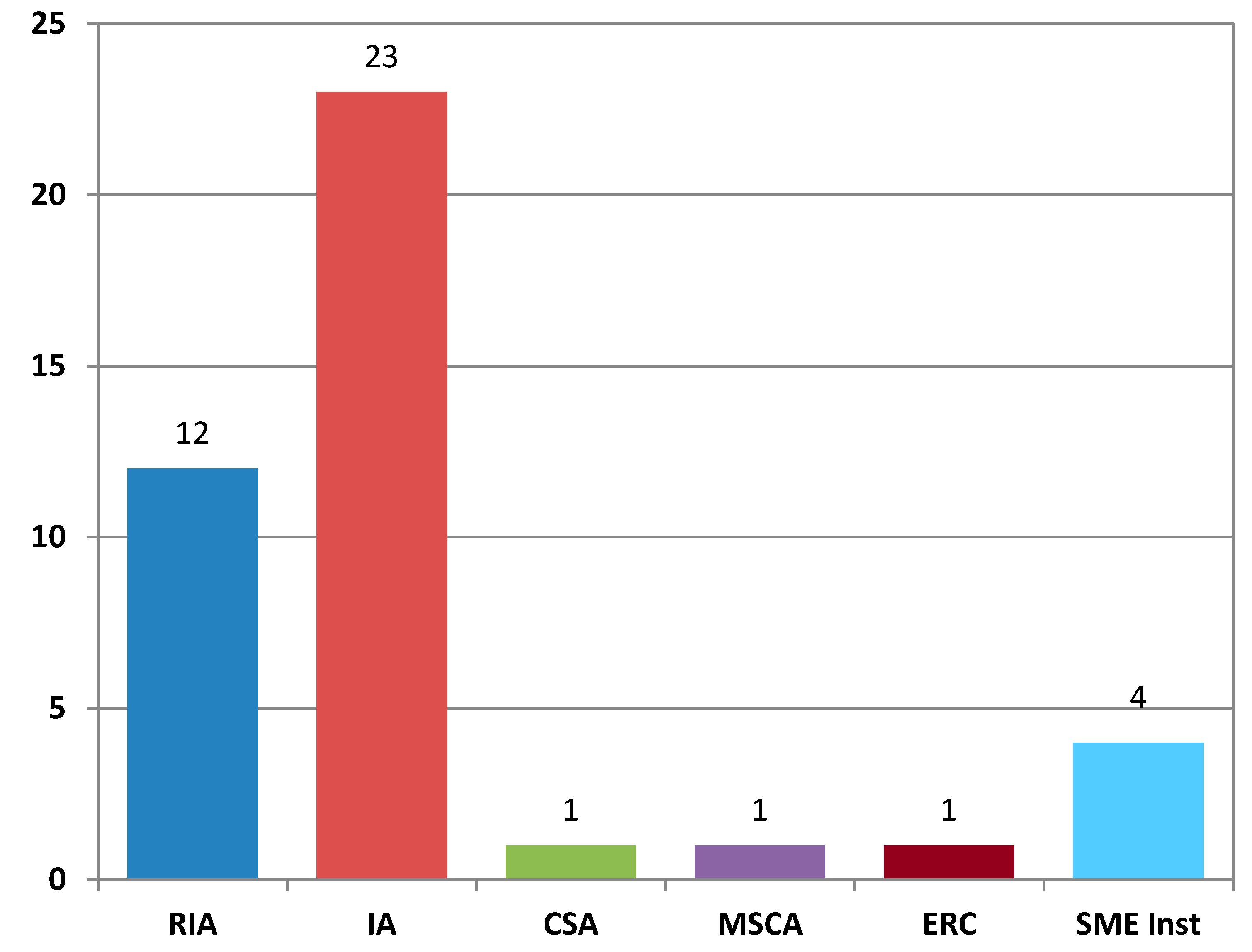
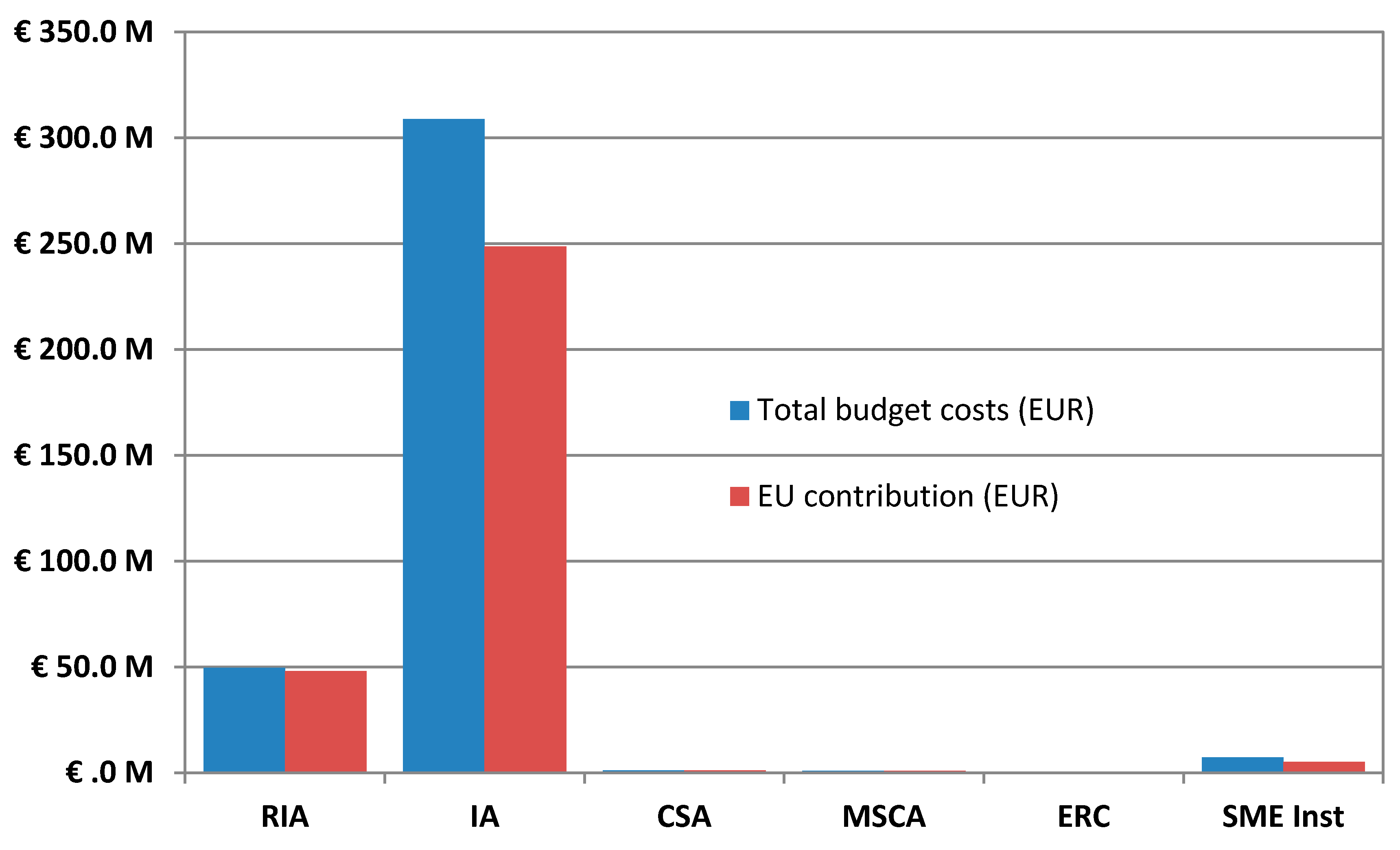
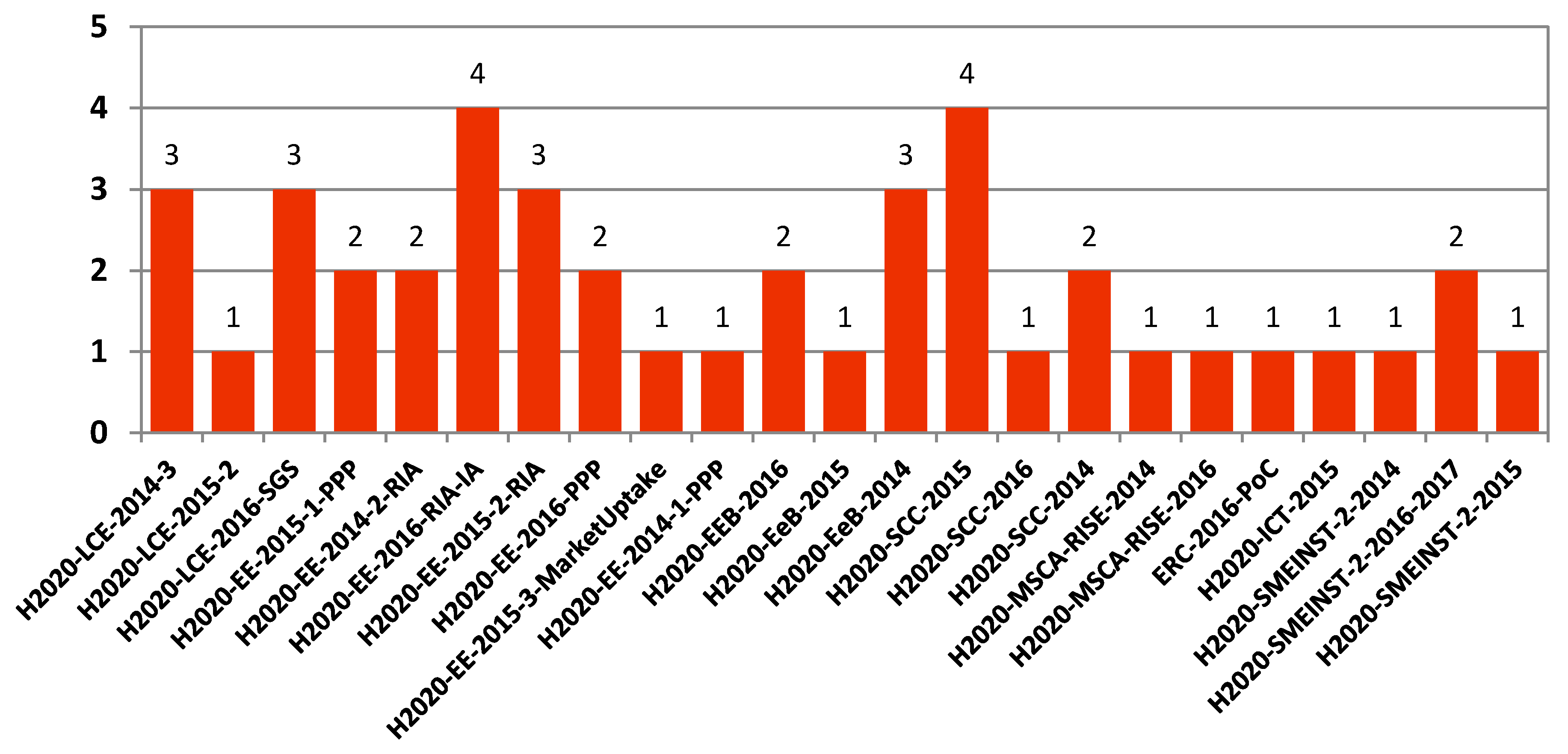

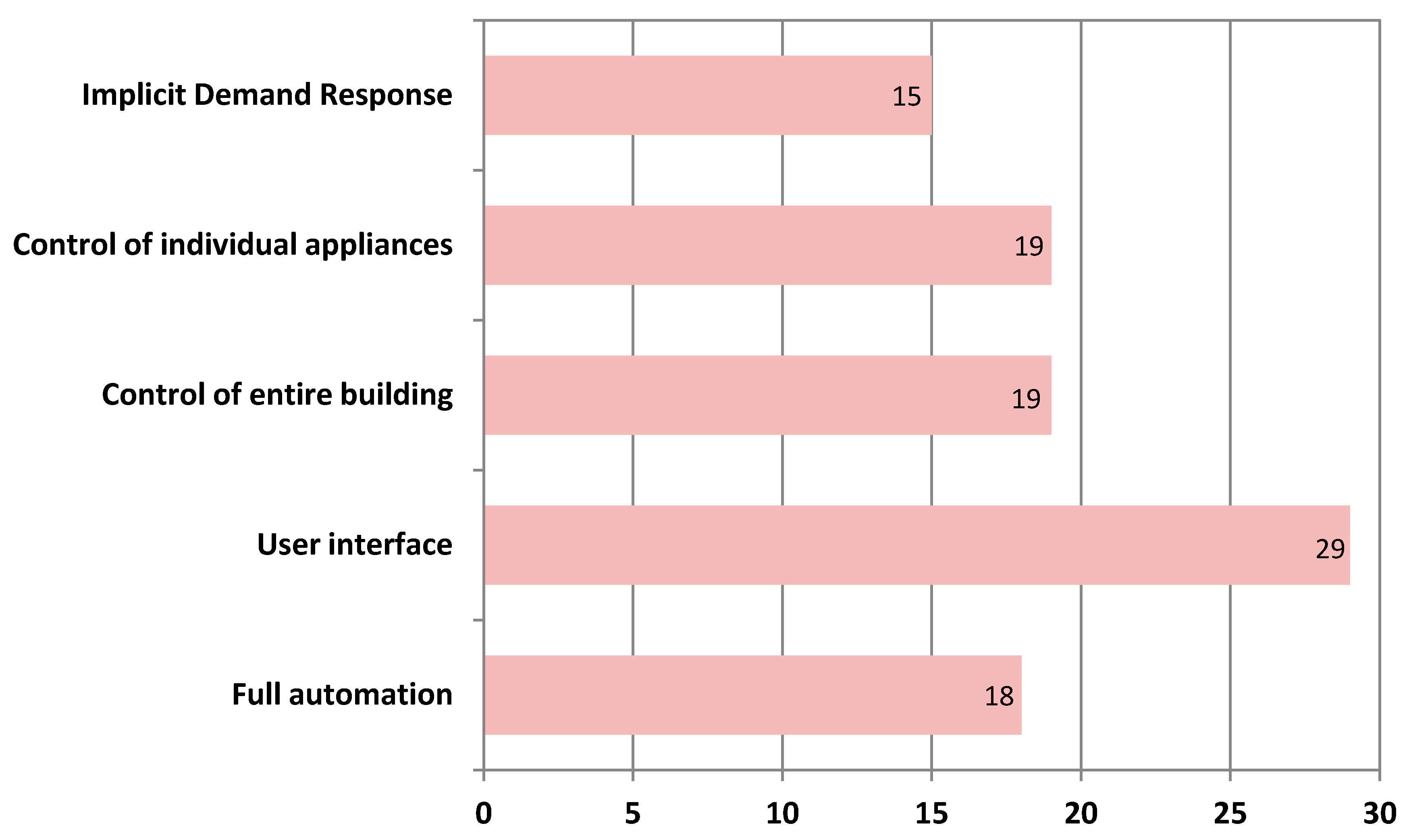
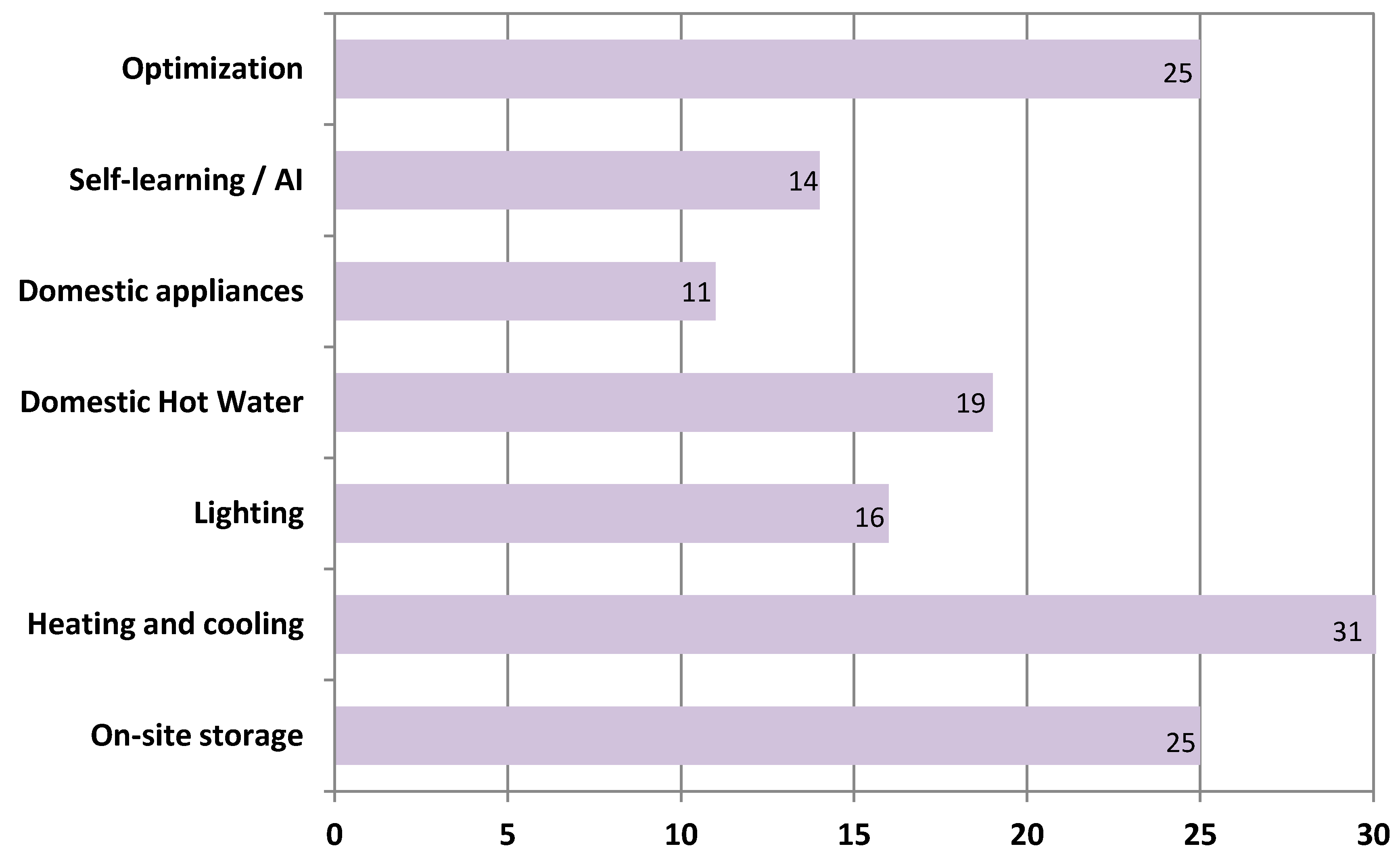
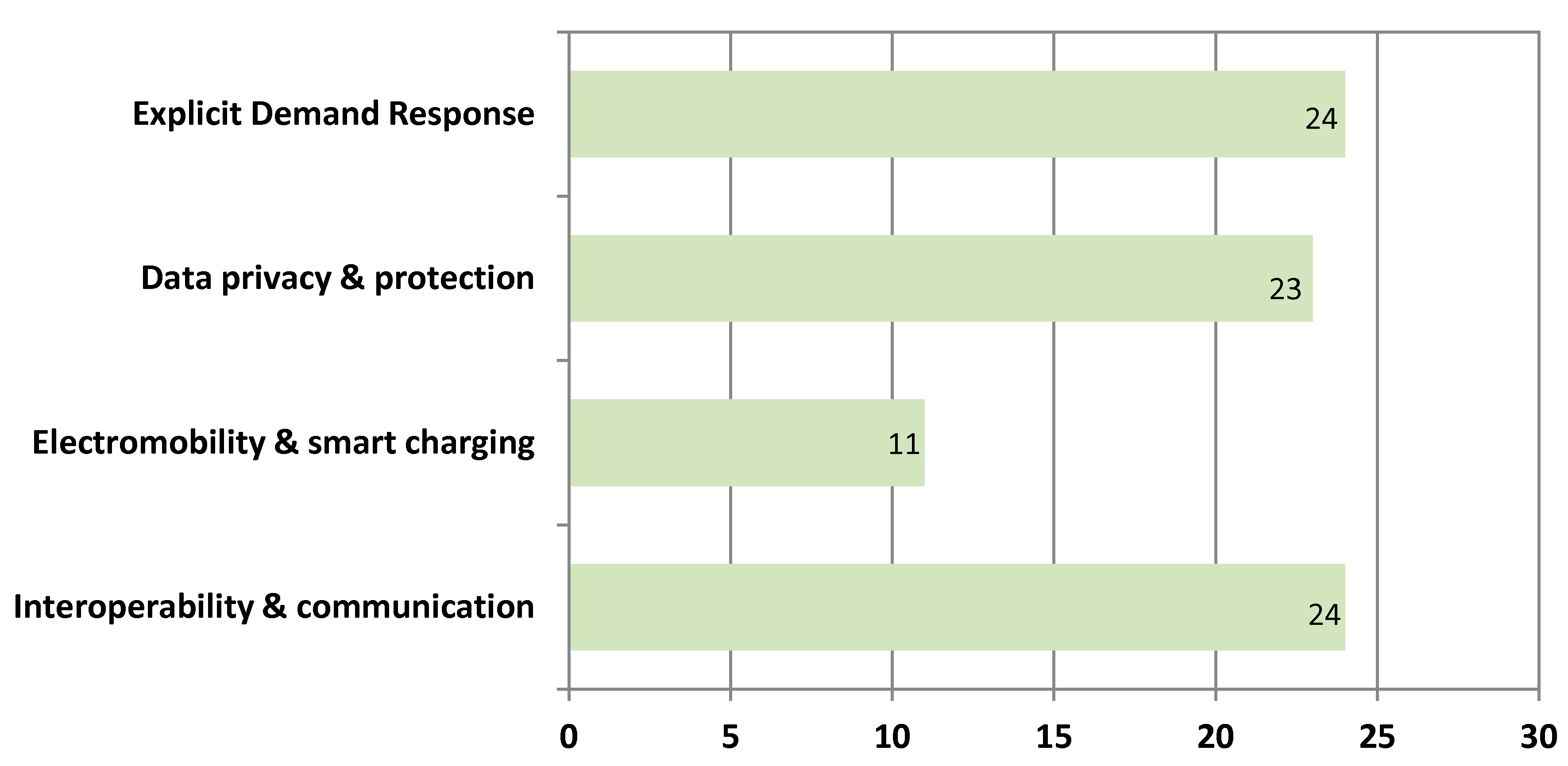
| Funding Scheme 1 | No. of Projects | Total Budget Costs (EUR) | EU Contribution (EUR) |
|---|---|---|---|
| RIA | 12 | € 49.5 M | € 48.1 M |
| IA | 23 | € 308.9 M | € 248.7 M |
| CSA | 1 | € 1.1 M | € 1.1 M |
| MSCA | 1 | € 1.0 M | € 1.0 M |
| ERC | 1 | € 0.1 M | € 0.1 M |
| SME Inst | 4 | € 7.3 M | € 5.1 M |
| Total | 42 | € 367.9 M | € 304.1 M |
© 2017 by the author. Licensee MDPI, Basel, Switzerland. This article is an open access article distributed under the terms and conditions of the Creative Commons Attribution (CC BY) license (http://creativecommons.org/licenses/by/4.0/).
Share and Cite
Moseley, P. EU Support for Innovation and Market Uptake in Smart Buildings under the Horizon 2020 Framework Programme. Buildings 2017, 7, 105. https://doi.org/10.3390/buildings7040105
Moseley P. EU Support for Innovation and Market Uptake in Smart Buildings under the Horizon 2020 Framework Programme. Buildings. 2017; 7(4):105. https://doi.org/10.3390/buildings7040105
Chicago/Turabian StyleMoseley, Philippe. 2017. "EU Support for Innovation and Market Uptake in Smart Buildings under the Horizon 2020 Framework Programme" Buildings 7, no. 4: 105. https://doi.org/10.3390/buildings7040105




